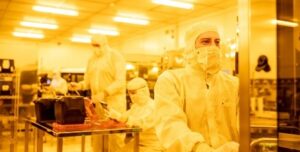


Photolithography (on top) and wafer handling (middle) in the ISIT cleanroom; PRECISE sensor elements on a silicon wafer (below).
Together with the project partners, the Fraunhofer Institute for Silicon Technology (ISIT) develops and manufactures the sensor elements for the PRECISE Meat Quality Sensor.
The use of MEMS technology (micro-electro-mechanical systems) enables the production of sensors that are small, light and energy-efficient, making them ideal for mobile applications. The production of MEMS is similar to the manufacture of semiconductor chips, but with additional steps to create three-dimensional structures. The most important steps include the application of thin layers of material on silicon substrates (wafers), the creation of patterns on the substrate using light and light-sensitive paint (photolithography) and the removal of unwanted parts of the layers or substrate by chemical or physical processes (etching). Multiple combinations of the corresponding steps allow the creation of complex structures that can ultimately be used as sensors by cutting the wafer into individual MEMS components. The main features of MEMS technology are miniaturisation, efficient integration of mechanical and electronic functions, versatile application possibilities, precision for high accuracy of the sensors and the possibility of mass production.
The PRECISE sensor elements are piezo bending beams that are able to detect the smallest changes in mass, making them ideal for applications in gas sensor technology. The bending beam is made of piezoelectric material that deforms when an electrical voltage is applied, creating a mechanical movement. Each bending beam has a specific resonant frequency at which it vibrates most efficiently and this frequency depends on the mass of the beam. If an additional mass, such as gas molecules, is added to the bending beam, the total mass of the system increases and leads to a reduction in the resonant frequency. By monitoring the changes in resonant frequency, the bending beam can be used as a sensor. When gases adsorb on the beam, the mass and therefore the resonant frequency changes. This change can be measured and used to determine the amount of gas.
For monitoring the freshness of meat and fish, the PRECISE sensor is designed to detect the gas cadaverine, as the amount of cadaverine emission increases over time and is therefore a measure of food spoilage.
